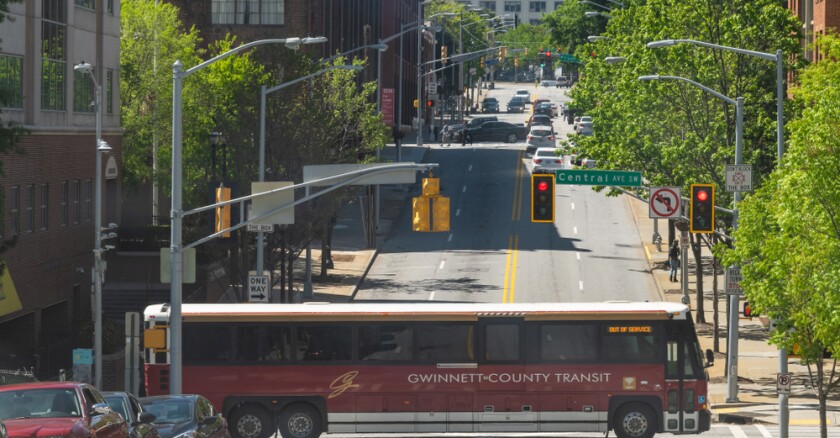In Brief:
After a string of tough defeats going back decades, voters in Gwinnett County, Ga., a growing suburban area bordering on Atlanta, could soon be asked again to approve new funding for public transit.
Last month, the Gwinnett County commissioners approved a Transit Development Plan that would cost an estimated $17 billion to implement. While the financing has yet to be determined, county leaders say it’s likely they’ll ask voters to approve a one-cent sales tax to pay for the improvements, with a referendum coming as soon as next November.
“This is a plan for Gwinnett County residents,” says China Thomas, director of transit capital improvement projects for the county. “That is what we really wanted to emphasize.”
‘No MARTA’
Metropolitan Atlanta is a famously car-centric place — “America’s poster child for dysfunctional, racially inequitable, environmentally unsustainable urban mobility,” as Rob Gioielli, an urban historian at the University of Cincinnati, has written. Atlanta itself has limited transit service, and roads and highways provide the only meaningful regional connections. That’s partly because the suburban counties, where anti-transit sentiments have been closely linked with racist attitudes about the city, have long rejected proposals to join MARTA.
Gwinnett County residents last voted against a proposal to join MARTA in 2019. It would have improved bus service in the county and created commuter rail connections to the city. After the plan was rejected, county leaders brought a very similar proposal to voters again the following year, only leaving out MARTA as the operator of heavy rail and other services. That referendum failed too, but by a much smaller margin.
Ben Ku, a Gwinnett County commissioner, was a proponent of the previous iteration of the plan, including the proposed heavy rail connections to the city and the Hartsfield-Jackson Atlanta International Airport. But residents made it clear they don’t want to be part of MARTA, and the new plan favors countywide microtransit service along with lower-cost bus rapid transit, instead of rail.
“Without MARTA being a part of this, it really allows us to focus on the needs of Gwinnett County,” Ku says.
More Service, Lower Capital Costs
Gwinnett County has grown much more populous and diverse over the last few decades, with 20 percent growth since 2010 alone. It’s projecting a population of 1,029,000 people by 2025, with another half-million by 2050. The county’s newest residents tend to be younger and more favorable to multimodal transportation infrastructure, according to the county’s Transit Development Plan. But a weakness of previous proposals was that they would have invested most heavily in a few high-frequency connections and left much of the county out.
“Building on the last plan, we recognized that people needed to see how transit was going to benefit their area,” says Nicole Love Hendrickson, the Gwinnett County Board of Commissioners chairwoman. “The last plan didn’t provide enough of that coverage around the whole county. [Residents] saw MARTA and they completely shut down.”
County land is built out in a low-density pattern — a “carpet of sprawl,” says Darin Givens, an urbanist advocate based in Atlanta — with relatively few dense corridors that are ideal for traditional transit service. But the growing trend of microtransit, which provides on-demand shuttle service to anywhere within a certain zone, allows the county to cover more territory.
After the last referendum failed, Gwinnett County moved ahead with setting up two microtransit zones. The new Transit Development Plan proposes expanding the service to the entire county by 2033. Microtransit is “a quick win that could be used to make the case for future investment,” according to the plan. Along with other transit services, backers say it could help relieve congestion on county roads.
“I can confidently say that you can get anywhere in Gwinnett without a car [under this plan],” says Ku. “Some people will use it, and anybody could use it, but it’s going to benefit people whether they use it or not.”
In addition to microtransit, the plan recommends building out a 26-mile bus rapid transit (BRT) line, with “features such as offboard fare payment, bus-only lanes, limited stops, queue jumps and transit signal priority.” It also calls for expanding traditional bus service and providing new “quick ride” or “bus rapid transit lite” service, with some BRT features. It would establish two routes to Hartsfield-Jackson, the nation’s busiest airport, running hourly service 14 hours a day.
Will the Proposal Work?
Commissioners and planners completely overhauled the plan after the 2020 defeat, taking into account both what they saw as residents’ opposition to joining MARTA and their skepticism about the value of heavy rail service relative to how much time and money it costs to build. The current proposal is “a perfect mix” of services for transit within Gwinnett County, says Givens, the Atlanta-based advocate. But leaving out heavy rail — still “the sexiest, most headline-grabbing type of transit you can do” — could work against the plan too, if it fails to get people excited about the proposals.
County leaders stress that a financing plan hasn’t been approved yet, and there’s no referendum scheduled. The Atlanta-Region Transit Link Authority, which coordinates regional transit investments, will review the plan over the next few months. (The authority declined an interview request.) Leaders acknowledge that even with a revised plan that takes into account months of resident input, winning a sales tax referendum is far from a sure thing. But they have to try, and given the inflation of construction costs and the timeline for federal funding, it’s better to try sooner than later, says Hendrickson.
“Yes, I do worry. There’s so much unknown,” Hendrickson says. “But I’m committed to doing what I set out to do, which is to assure mobility for all. And I know there are people in our community who cannot wait.”












